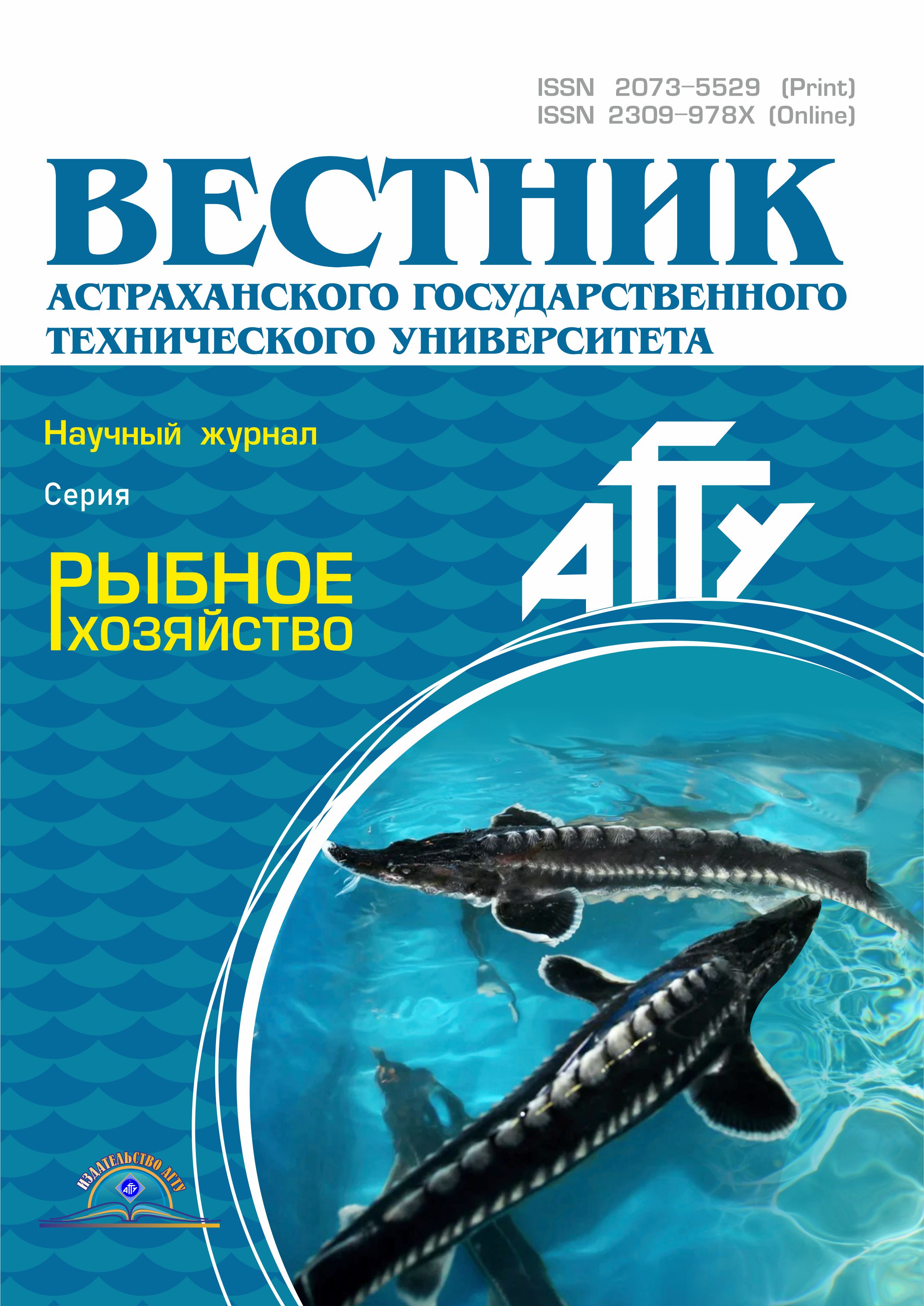CSCSTI 34.39
CSCSTI 62.13
CSCSTI 69.01
CSCSTI 69.25
CSCSTI 69.31
CSCSTI 69.51
CSCSTI 87.19
The article gives the results of the study of the fatness and chemical composition of skeletal muscles of underyearling Esox lucius L., grown in different fish-farms of the Yaroslavl and Volgograd regions. The fish was measured, weighed; Foultin’s fatness coefficient was calculated. The amount of water, dry matter, fat, protein, minerals and nitrogen-free extractives were determined in the muscle tissue of the test specimens. In autumn yearlings of both fish farms approach 100 g weight, average body length being 19-21 cm. At the age 2+ pike juveniles of the Volgograd fish farm (sole trader - “Head of the Peasant farm Lozina Ya.V.”) overtake those grown in “Stimul” fish farm, Ltd. in Yaroslavl region in size and mass. However, Fultin’s condition factor in individuals of the Yaroslavl region was significantly higher than in the young from Ya. V. Lozina’s fish farm. There were no statistically significant differences between the water content, protein content, fat content, and nitrogen-free extractives in the skeletal muscles of pike underyearlings from different enterprises. Though, there was registered a significant increase in the amount of mineral substances in the muscle tissue of pike underyearlings from “Stimul”, Ltd ( p < 0,05). On average, muscular tissue of pike underyearlings from “Stimul”, Ltd was larger than that of Ya.V. Lozina’s fish farm in terms of nutrient content and energy value. The study results showed that fatness and chemical composition of the muscle tissue of pike yearlings is more influenced by the sufficient food supply than hydrochemical conditions of the pond.
growth rate, chemical composition, muscle tissue, fingerlings, pike, Fultin’s condition factor
1. Konchic V. V., Usova O. V. Tehnologicheskie parametry perevoda lichinok lenskogo osetra na iskusstvennye korma v usloviyah Respubliki Belarus' // Ribogospodars'ka nauka Ukraїni. 2011. № 4. S. 73-80.
2. Gruzdeva M. A. Feneticheskoe raznoobrazie schuk (sem. Esocidae) Evrazii: avtoref. dis.. kand. biol. nauk. M., 1996. 18 s.
3. Kostyleva A. A., Flerova E. A. Osobennosti himicheskogo sostava myshechnoy tkani lescha Abramis brama Gor'kovskogo vodohranilischa // Vopr. rybolovstva. 2015. T. 16. № 4. S. 412-418.
4. Payuta A. A., Flerova E. A. Osobennosti himicheskogo sostava skeletnyh myshc, pecheni i gonad u leschey Abramis brama L. raznogo vozrasta // Problemy biologii produktivnyh zhivotnyh. 2017. № 2. S. 38-50.
5. Miroshnichenko D. A. Sravnitel'naya harakteristika pokazateley obmena veschestv predstaviteley Clarias batrachus, obitayuschih v estestvennyh i iskusstvennyh usloviyah // Innovacii v APK: problemy i perspektivy. 2016. № 1 (9). S. 110-114.
6. Payuta A. A. Analiz pokazateley obmena veschestv karpovyh ryb kak odnogo iz sposobov ocenki zagryazneniy vodnyh ekosistem // Setevoy zhurnal OrelGAU. 2016. № 2 (7). S. 22-28.
7. Payuta A. A., Flerova E. A. Osobennosti nakopleniya produktov obmena veschestv v myshechnoy tkani razlichnyh polovozrastnyh grupp lescha Abramis brama L. Rybinskogo vodohranilischa // Vestn. APK Verhnevolzh'ya. 2017. № 1. S. 23-28.
8. Zaboukas N., Miliou H., Megalofonou P., Moraitou-Apostolopoulou M. Biochemical composition of the Atlantic bonito Sarda sarda from the Aegean Sea (eastern Mediterranean Sea) in different stages of sexual maturity // J. Fish Biol. 2006. V. 69. N. 2. P. 347-362.
9. Pravdin I. F. Rukovodstvo po izucheniyu ryb. M.: Pisch. prom-st', 1966. 376 s.
10. Flerova E. A. Fiziologo-biohimicheskie metody issledovaniya ryb. Yaroslavl': Izd-vo Yaroslavskoy GSHA, 2014. 40 s.
11. Yeganeh S., Shabanpour B., Hosseini H., Imanpour M. R., Shabani A. Comparison of Farmed and Wild Common Carp (Cyprinus carpio): Seasonal Variations in Chemical Composition and Fatty Acid Profile // Czech Journal of Food Sciences. 2012. V. 30. N. 6. P. 503-511.
12. Booth D. J., Keast J. A. Growth energy partitioning by juvenile bluegill sunfish, Lepomis macrochirus Rafinesque // Journal of Fish Biology. 1986. V. 28. N. 1. P. 37-45.
13. Privezencev Yu. A. Vyraschivanie ryb v malyh vodoemah. M.: Kolos, 2000. 120 s.
14. Bhatnagar A., Devi P. Water quality guidelines for the management of pond fish culture // International Journal of Environmental Sciences. 2013. V. 3. N. 6. P. 1980-2009.
15. Kovalenko E. O. Morfobiologicheskaya harakteristika sudaka (Sander lucioperca, L.) i ego rol' v ekosisteme Krasnodarskogo vodohranilischa: avtoref. dis.. kand. biol. nauk. Krasnodar, 2015. 24 s.
16. Hristenko D. S., Kotovskaya A. A., Rudik-Leuskaya N. Ya. Osobennosti biologii schuki obyknovennoy (Esox lucius L.) v tovarnyh rybnyh hozyaystvah lesostepnoy zony Ukrainy // Nauch. tr. Sworld. 2013. T. 37. № 1. S. 45-51.
17. Jin S., Yan X., Zhang H., Fan W. Weight-length relationships and Fulton’s condition factors of skipjack tuna (Katsuwonus pelamis) in the western and central Pacific Ocean. Peer J. 2015. V. 3, e758. DOI:https://doi.org/10.7717/peerj.758.
18. Mello L. G. S., Rose G. A. Seasonal cycles in weight and condition in Atlantic cod (Gadus morhua L.) in relation to fisheries // ICES Journal of Marine Science. 2005. V. 62. N. 5. P. 1006-1015.
19. Dvoryaninova O. P., S'yanov D. A. Ispol'zovanie biotehnologicheskogo potenciala presnovodnyh bioresursov s cel'yu polucheniya kachestvennoy i bezopasnoy ryboprodukcii // Vestn. VGAU. 2013. № 4. S. 199-204.
20. Lesnikova E. G. Rybovodno-biologicheskie osobennosti iskusstvennogo vosproizvodstva schuki (Esox lucius L.) v usloviyah Kaliningradskoy oblasti: avtoref. dis.. kand. biol. nauk. Kaliningrad, 2004. 22 s.
















